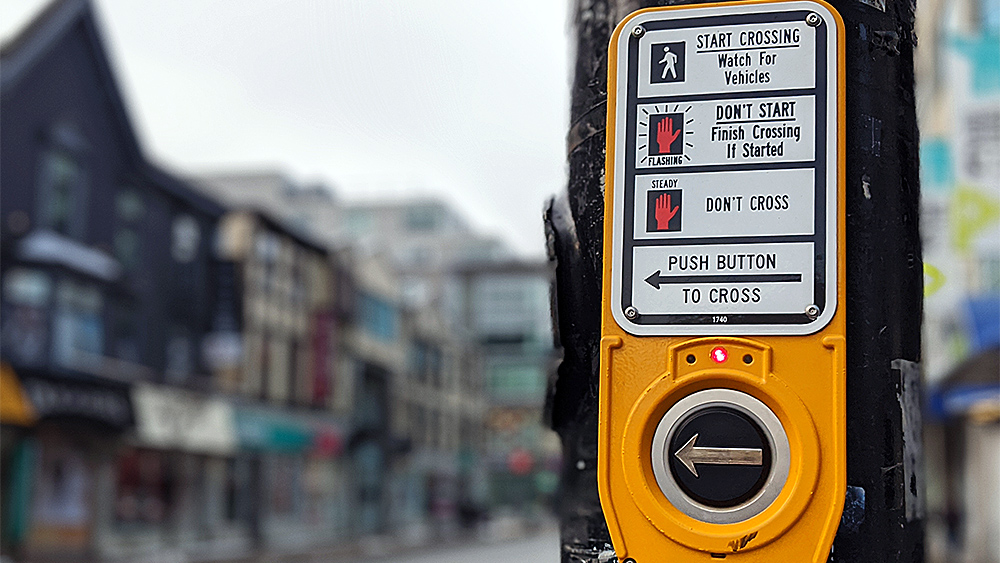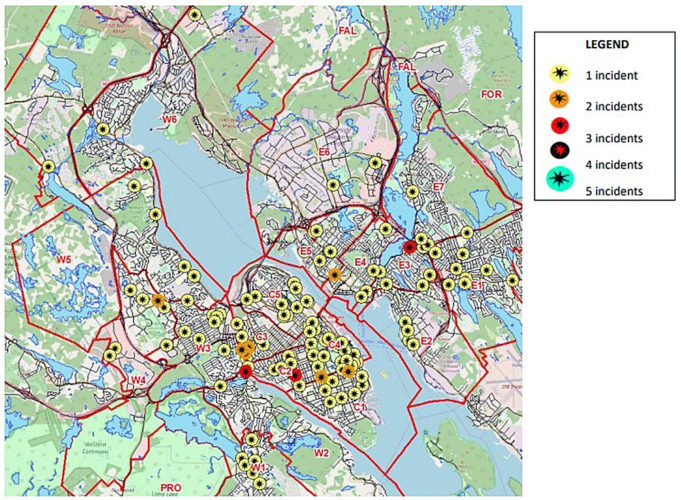HRM still moving toward zero traffic injuries and fatalities
HRP reports 168 pedestrian collisions last year, down from 217 in 2018

caption
An LPI (leading pedestrian intersection) at Spring Garden Road and Queen Street. LPI's give pedestrians a head start to cross before vehicles get the green light.Pedestrian infrastructure might seem low on the city’s priority list, but a presentation made to the transportation standing committee on Thursday suggests otherwise.
The improvements laid out in the presentation aim to reduce traffic related fatalities and injuries by 20 per cent within five years. Council set this goal after approving the Strategic Road Safety Plan in 2018.
Transportation and Road Safety Engineer Jill Morrison said that one priority is designing the transportation network to enable safe and convenient transportation for all users.
“This includes giving walking, cycling and transit a greater level of consideration when allocating road right of way,” Morrison said in her presentation to council. Related stories
The countermeasures that aim to reduce the frequency and severity of pedestrian collisions fall under three main categories according to Morrison: engineering, education and enforcement.
The engineering category includes infrastructure changes like accessible pedestrian signals which are now standard on all new crosswalks.
Eight signalized crosswalks have also been equipped with leading pedestrian intervals (LPI) which give pedestrians a three to seven second head start when entering an intersection before vehicles can advance.
Education countermeasures refer to outreach campaigns in schools and communities to promote safer behaviours. The city launched the Heads Up, Halifax campaign in 2014 in hopes to raise awareness about the shared responsibility of road safety between drivers and pedestrians.
“Enforcement of traffic calming continues on approximately 10 to 12 streets per year. The highest ranked streets and integration opportunities are prioritized first,” said Morrison.
Traffic calming reduces speed limits in residential neighbourhoods with the help of Halifax Regional Police (HRP).
“With the data more readily available, we are in a better position to make data-driven decisions. This includes identifying high risk locations and corridors, and selecting appropriate countermeasures,” said Morrison.
District 7 Coun. Waye Mason said he liked that the presentation clearly laid out the measures being taken to protect pedestrians.
“There are people in the community who say that nothing is being done, when in fact a tremendous amount is being done,” Mason said. “When you look at the way things have changed even in the last six or seven years with these various interventions.”
Mason said he’d like to see the potential changes from a budgetary standpoint as well.
“The big thing we keep hearing from everyone is ‘How much money will it take?’ What I would like to see is how many intersections, how many crosswalks; how much would it cost?” Mason said.
The price of safety
Pedestrian safety advocate Martyn Williams said that while cost can be the main interest for taxpayers, it’s also about the city’s priorities.
“The general perception by the public is that this kind of thing is very expensive, that you need to spend a huge amount of money to make things safe for pedestrians,” said Williams.
“In fact, that’s often not the case, it can just be simple things like reallocating road space to other forms of transit. That way by making roads narrower and reallocating that space, you already have a much safer road that people can cross easily.”
Williams started HRM Safe Streets for Everyone, a group on Facebook that gives citizens a platform to share pedestrian safety issues in the city. He also runs an account on Twitter by the same name.
“Incidents are clustered in certain places, and if you drill down to the infrastructure causes and it’s sometimes very simple issues, not necessarily needing a complete redesign of the roads that are causing incidents time and time again,” he said.
HRP and Halifax District RCMP released a report on Jan. 14 including data on pedestrian collisions occurring in HRM in 2019.

caption
The HRP report broke the collision data down by district, including all regions in the HRM.The report shows the total number of vehicle/pedestrian collisions at 168, 22 per cent lower than the total of 217 in 2018.
The report also shows a map of HRM, marking where each collision occurred.
“There are a few hot spots like that which we need to focus on to make Vision Zero seem real here. We can’t just reduce speed limits in residential areas and say we’re doing it,” said Williams. “We need to concentrate on the incident hot spots and work our way from there.”
Vision Zero is a multi-national road traffic safety project that aims to achieve zero injuries or fatalities involving road traffic. It originated in Sweden and was approved by Swedish parliament in 1997.
Halifax’s Strategic Road Safety Plan (SRSP) is a version of Vision Zero passed by regional council in 2018 aimed to move toward zero deaths and injuries by 2038. The core principle stayed the same but was instead called Towards Zero.
The plan cited: “Towards Zero has a similar intent as Vision Zero but recognizes the reality that zero deaths and injuries cannot be accomplished in the immediate future.”
Williams believes that Vision Zero is still possible.
“It’s a process where you look at incident data, and you get down to the root cause of incidents. ‘Why are people making mistakes at this intersection?’ Then you resolve that through eliminating human error and putting in an infrastructure solution.”
The city’s manager of traffic management, Taso Koutroulakis, said that data collection is the first step to making infrastructure changes.
“Then we’ll look at the data closely and see what kind of mitigating measures we can employ,” said Koutroulakis. “Depending on what sort of options we have, if it will have a budgetary impact, or if it could be as simple as changing a sign, or building a brand new crosswalk. There’s a lot of moving parts.”
Koutroulakis said HRM Traffic Management also plans to create an online resource so people can be aware of the infrastructure improvements as they develop.

caption
Manager of traffic management Taso Koutroulakis presented data to council yesterday on potential future improvements to pedestrian infrastructure.“We’re intending to create a traffic safety dashboard so anybody can go online and see exactly how many improvements have been made and where they’ve been made,” he said. “We’re going to try to launch a version of this by June or July. The intent is to include improvements as well as collision statistics.”
Transportation standing committee chair Lorelei Nicoll said she hopes to see the downward trend in collisions continue.
“At the end of the day it’s about trying different things and seeing what will keep our pedestrians safer,” said Coun. Nicoll.
The transportation standing committee’s next meeting is scheduled for Feb. 27.
About the author
Benjamin Elliott
Ben Elliott is a reporter for the Signal at King's College in Halifax. He got his HBA in Communication Studies from the University of Waterloo...

N
Norm Collins